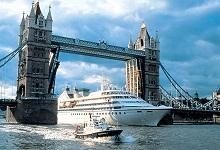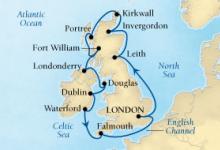Recently Viewed Cruises
- Pride, Route of Britannia ex London ReturnAdd to favourites
- Pride, British Isles & Atlantic Harbors ex London to LisbonAdd to favourites
- Pride, British Isles, Atlantic & Iberia ex London to Monte CarloAdd to favourites
- Ocean Countess, Mini Cruise ex Newcastle to TilburyAdd to favourites
- Wind Surf, ex Dublin to PortsmouthAdd to favourites
- Catch up on Cruising: Latest cruise news in bite size
- Royal Caribbean International raises the bar
- Classy Astor fills gap in market
- Oceanic Discoverer
- Ab Fab Oosterdam
- Frequently Asked Questions
-
Pride, Route of Britannia ex London Return
Nights 15 Ship Seabourn Pride Star Rating 
Departs London, (London Bridge) England Sailing 2013: 1 Sep Ports of Call London, Edinburgh, Invergordon, Kirkwall, Dunvegan, Fort William, Londonderry, Douglas More Dublin, Dunmore East(Waterford), Falmouth Please enquire about this cruise for pricing.


15 Night Cruise sailing from London roundtrip aboard Seabourn Pride.
The ship that started it all inspired one critic to declare that "Seabourn is in a class by itself." And in 1988, when the sleek, 10,000-ton Pride emerged from the Schichau Seebeckwerft shipyard in Bremerhaven, Germany, that was literally true.
At that time, most ships of Pride's size (and there were more then than now) carried more than 400 guests. Seabourn Pride, christened by Ambassador Shirley Temple Black, topped out at half that many.
The idea that every guest sailed in an expansive, ocean-view suite was revolutionary. The concept of open-seating dining accommodating all guests was exceptional. And the notion of including nearly everything for the cost of the fare was a rare thing as well. But the most important element of the Seabourn experience, to founding president Warren S. Titus, was the unparalleled level of personalized service provided to guests.
Hand-picked staff, recruited from the finest European hospitality schools and hostelries, are re-trained and managed according to the philosophy that every request is a golden opportunity to create delight, that the unexpected pleasure is what truly makes an experience memorable, and that the rendering of the very best service is a product of professional pride, not influenced by the expectation of a gratuity.
That remains a core value of all Seabourn ships today. By a trick of history, Seabourn Pride and its sisters remain as exceptional today as they were when launched - in a class by themselves.
Highlights of this cruise:
Leith (Edinburgh)
Two miles distant from its ancient seaport of Leith lies Edinburgh, Scotland's national capital. The Scottish capital since the 15th century, Edinburgh is comprised of two distinct areas - the Old Town, dominated by a medieval fortress, and the neoclassical New Town, whose development from the 18th century onwards had a far-reaching influence on European urban planning. The harmonious juxtaposition of these two contrasting historic areas, each with many important buildings, is what gives the city its unique character.
Always favored by geography, Edinburgh is ideally situated on the Firth of Forth, an inlet from the North Sea, and built on extinct volcanoes surrounded by woods, rolling hills and lakes. On a clear day, there are glorious vistas from each of these hilltops. Looming above the city is the striking fairy tale castle built on the site of a 7th-century fortress. Towards the Middle Ages life within the fortress spilled onto the long ridge running to the foot of Arthur's Seat, which crowns Holyrood Park. The city's most legendary citizens are the arch Presbyterian John Knox and Mary Queen of Scots, who dominated the Edinburgh of the late 16th century. Edinburgh's delightful city center is a joy to explore on foot. Every alley reveals impressive steeples, jagged, chimney-potted skylines, or lovely rotund domes.
Invergordon
Invergordon, the port for Inverness, is located in the northern part of Scotland on the Moray Firth. The quaint town of Inverness has reminders of such historical figures as St. Columba, Mary Queen of Scots, and Oliver Cromwell. Its attractions include a 17th-century clock tower, part of a fort erected by Cromwell's army and the 19th-century cathedral. Regarded as the "Capital of the Highlands," the town holds many traditional Scottish events each summer.
Kirkwall
Six miles of turbulent waters known as the Pentland Firth separate the northeastern corner of Scotland from Orkney. This archipelago comprised of some 70 islands, only 28 inhabited by humans, was first settled by the Vikings in the 9th century. Ruled by Norway and Denmark until 1468, the islands were given to Scotland by a Norwegian King in lieu of a dowry for his daughter's marriage to James III. Kirkwall is the capital city, located on Mainland, the Orkney's largest island. Explore this fascinating town with its steep-roofed houses and medieval St. Magnus Cathedral, or venture further out of town to see some of the wealth of prehistoric sites, which dot the island. Although politically a part of Great Britain, the archipelago retains a strong sense of Norse traditions as evidenced by the architecture and crafts found here.
Dublin
Ireland's capital offers an almost inexhaustible number of attractions including stately public buildings, handsome 18th-century mansions, imposing statues, superb museums and art galleries, a magnificent cathedral, and Trinity College where the 8th-century Book of Kells is displayed, not to mention the tempting shops along Grafton Street. The proverbial Irish skill with words has richly rewarded the world with essays, novels, plays and poetry by authors ranging from Oliver Goldsmith, William Congreve, Jonathan Swift, George Bernard Shaw and Oscar Wilde to James Joyce, Sean O'Casey, Samuel Beckett and W.B. Yeats. This skill is not confined to the written word - the articulate Irish with their lilting, almost musical vernacular and conversational talent leave no doubt that the Irish genius extends to the spoken word as well.
Falmouth
Falmouth has a fine natural harbor, but has lost its earlier importance as a seaport and now caters mainly to yachts and boating for holidaymakers. Falmouth has the mildest winter climate in England.





